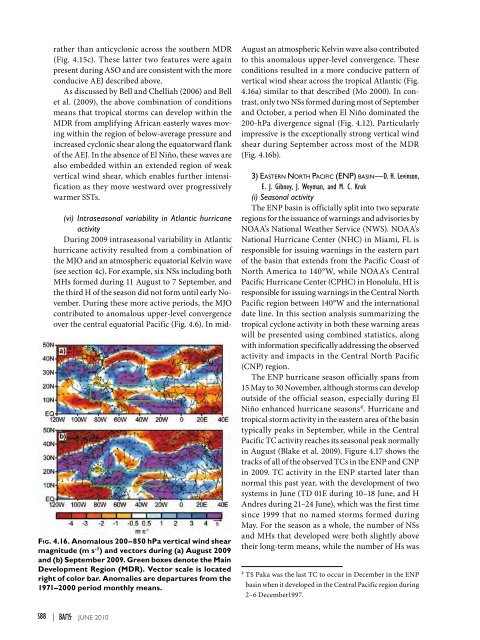Create successful ePaper yourself
Turn your PDF publications into a flip-book with our unique Google optimized e-Paper software.
ather than anticyclonic across the southern MDR(Fig. 4.15c). These latter two features were againpresent during ASO and are consistent with the moreconducive AEJ described above.As discussed by Bell and Chelliah (2006) and Bellet al. (<strong>2009</strong>), the above combination of conditionsmeans that tropical storms can develop within theMDR from amplifying African easterly waves movingwithin the region of below-average pressure andincreased cyclonic shear along the equatorward flankof the AEJ. In the absence of El Niño, these waves arealso embedded within an extended region of weakvertical wind shear, which enables further intensificationas they move westward over progressivelywarmer SSTs.(vi) Intraseasonal variability in Atlantic hurricaneactivityDuring <strong>2009</strong> intraseasonal variability in Atlantichurricane activity resulted from a combination ofthe MJO and an atmospheric equatorial Kelvin wave(see section 4c). For example, six NSs including bothMHs formed during 11 August to 7 September, andthe third H of the season did not form until early November.During these more active periods, the MJOcontributed to anomalous upper-level convergenceover the central equatorial Pacific (Fig. 4.6). In mid-Fig. 4.16. Anomalous 200–850 hPa vertical wind shearmagnitude (m s -1 ) and vectors during (a) August <strong>2009</strong>and (b) September <strong>2009</strong>. Green boxes denote the MainDevelopment Region (MDR). Vector scale is locatedright of color bar. Anomalies are departures from the1971–2000 period monthly means.August an atmospheric Kelvin wave also contributedto this anomalous upper-level convergence. Theseconditions resulted in a more conducive pattern ofvertical wind shear across the tropical Atlantic (Fig.4.16a) similar to that described (Mo 2000). In contrast,only two NSs formed during most of Septemberand October, a period when El Niño dominated the200-hPa divergence signal (Fig. 4.12). Particularlyimpressive is the exceptionally strong vertical windshear during September across most of the MDR(Fig. 4.16b).3) Eastern North Pacific (ENP) basin—D. H. Levinson,E. J. Gibney, J. Weyman, and M. C. Kruk(i) Seasonal activityThe ENP basin is officially split into two separateregions for the issuance of warnings and advisories byNOAA’s National Weather Service (NWS). NOAA’sNational Hurricane Center (NHC) in Miami, FL isresponsible for issuing warnings in the eastern partof the basin that extends from the Pacific Coast ofNorth America to 140°W, while NOAA’s CentralPacific Hurricane Center (CPHC) in Honolulu, HI isresponsible for issuing warnings in the Central NorthPacific region between 140°W and the internationaldate line. In this section analysis summarizing thetropical cyclone activity in both these warning areaswill be presented using combined statistics, alongwith information specifically addressing the observedactivity and impacts in the Central North Pacific(CNP) region.The ENP hurricane season officially spans from15 May to 30 November, although storms can developoutside of the official season, especially during ElNiño enhanced hurricane seasons 4 . Hurricane andtropical storm activity in the eastern area of the basintypically peaks in September, while in the CentralPacific TC activity reaches its seasonal peak normallyin August (Blake et al. <strong>2009</strong>). Figure 4.17 shows thetracks of all of the observed TCs in the ENP and CNPin <strong>2009</strong>. TC activity in the ENP started later thannormal this past year, with the development of twosystems in June (TD 01E during 10–18 June, and HAndres during 21–24 June), which was the first timesince 1999 that no named storms formed duringMay. For the season as a whole, the number of NSsand MHs that developed were both slightly abovetheir long-term means, while the number of Hs was4TS Paka was the last TC to occur in December in the ENPbasin when it developed in the Central Pacific region during2–6 December1997.S88 | juNE 2010
















